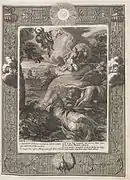Kobalos
The kobalos (pl. kobaloi) (Ancient Greek: κόβαλος, plural: κόβαλοι) was a sprite from Greek mythology, a mischievous creature fond of tricking and frightening mortals.[1] The kobaloi were companions of Dionysus and could shapeshift as Dionysus in the guise of Choroimanes-Aiolomorphos.[2] According to one myth, they robbed Herakles while he slept. He captured them in revenge but took pity on them when he found them amusing. In one version of the myth, Herakles gave them to the Lydian queen Omphale as a gift. The kobaloi were thought to live in Euboea or near Thermopylae.[3] Parents used tales of the kobaloi to frighten children into behaving.[4]
Definition
Greek myths depict the kobaloi as "impudent, thieving, droll, idle, mischievous, gnome-dwarfs",[3] and as "funny, little tricksy elves" of a phallic nature.[5] The term also means "impudent knave, arrant rogue" in ancient Greek, and such individuals were thought to invoke kobaloi spirits.[6] Depictions of kobaloi are common in ancient Greek art.
Modern associations
The kobalos is related to two other Greek sprites: the kabeiroi (pygmies with large phalluses) and the kerkopes.[3] The kobalos and kabeiroi came to be equated.[3] Nineteenth Century classicists proposed that other European sprites may derive from belief in kobaloi. This includes spirits such as the Northern English boggart, Scottish bogle, French goblin, Medieval gobelinus, German kobold, and English Puck.[7] Likewise, the names of many European spirits may derive from the word kobalos. The word entered Latin as cobalus, then possibly French as gobelin. From this, the English goblin and Welsh coblyn may derive.[8]
Notes
- Roby, John (1829). Traditions of Lancashire. Quoted in Hardwick 139. The sources spell the word khobalus.
- Brown 231.
- Brown 230.
- Davis 61.
- Brown 230–231.
- Liddell and Scott.
- Hardwick 139.
- Franklin 108.
References
- Brown, Robert (2004 [xxxx]). The Greek Dionysiak Myth, Part 2. Kessinger Publishing. ISBN 0-7661-8465-X.
- Davis, William Stearns (1914). A Day in Old Athens: A Picture of Athenian Life. Boston, Massachusetts: Allyn and Bacon.
- Franklin, Anna (2002). "Goblin", The Illustrated Encyclopedia of Fairies. London: Paper Tiger. ISBN 1-84340-240-8.
- Hardwick, Charles (1980 [1872]). Traditions, Superstitions, and Folk-lore, (Chiefly Lancashire and the North of England:) Their Affinity to Others in Widely-distributed Localities; their Eastern Origins and Mythical Significance. London: Simpkin, Marshall & Co.
- Liddell, Henry George, and Robert Scott (1940). A Greek-English Lexicon, revised and augmented throughout by Sir Henry Stuart Jones with the assistance of Roderick McKenzie. Oxford: Clarendon Press. ISBN 0-19-864226-1. Online version accessed 25 February 2008.
.jpg.webp)
.jpg.webp)
